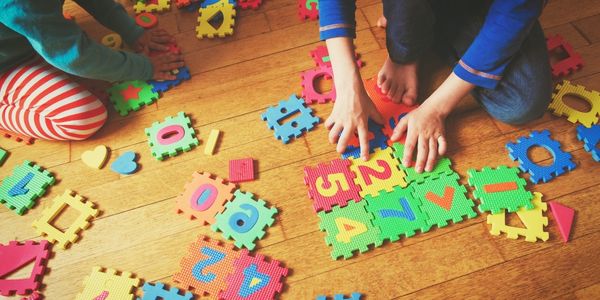
It’s hard not to smile when you see young kids take part in imaginative play. The pile of pillows in the living room becomes a pirate ship, their friends and siblings become a fearsome gang of treasure-hungry swashbucklers and the dog’s now pulling double duty as a man-eating shark.
These kids’ pirate adventures may just seem like some simple afternoon of fun, but they’re actually engaging in a positive learning experience called dramatic play. You may have heard of dramatic play before, but do you know what it is or why it matters for your kids?
Believe it or not, something as simple as an hour of pretend playtime can provide real benefits to children’s cognitive development. We have the scoop on what dramatic play entails, why it matters and how you can encourage this activity with your kids.
What is dramatic play?
While academic research using terms like “sociodramatic play” to describe this activity might make it sound like an intimidating concept to grasp, you’re probably already familiar with dramatic play.
“Dramatic play, also called pretend play, involves acting out real-world situations and taking on the roles of different characters,” says Lily Jones, former kindergarten teacher and founder of Curiosity Forever.
"Children use dramatic play to explore their own thoughts and feelings."
There are two primary types of dramatic play: structured and unstructured. Unstructured dramatic play gives children the freedom to choose their own roles and play scenarios. Structured dramatic play, on the other hand, has specific guidelines or prompts to get them started. Children are presented with a pre-determined scenario and then must make choices and discover solutions.
Both structured and unstructured dramatic play are important for your children’s emotional and social development. Maybe you remember dramatic play from your own childhood as “make-believe” or “playing house.” Whatever you want to call it, it’s an important opportunity for kids to act out scenarios from the real world and fictional lands alike.
6 Reasons why dramatic play for toddlers is important
Dramatic play is an integral part of a child’s social, emotional and cognitive development. Here are six important aspects of dramatic play:
1. Dramatic play teaches self-regulation
Toddlers and preschoolers are known for acting impulsively, but dramatic play is a positive steppingstone toward self-regulation. While they’re still figuring out what is or isn’t appropriate for a situation, children tend to be motivated to follow the “rules” of a pretend play scenario and learn to stick to their roles in a way that is acceptable to the group. This helps them grow in their ability to inhibit their impulses, coordinate with others and make plans.
2. Dramatic play gives children an emotional outlet
Dramatic play allows kids to act out scenarios they’ve seen or heard in real life, giving them an important emotional outlet as they explore new situations. “Young children do not yet think internally,” explains Barbara E. Harvey, executive director of Parents, Teachers and Advocates. “Children use dramatic play to explore their own thoughts and feelings.”
This is especially important for children who have seen something upsetting or scary in their daily lives. Dramatic play gives them an opportunity to sort through difficult emotions and “practice being in the world,” according to Jones.
3. Dramatic play teaches conflict resolution
Both unstructured and structured dramatic play offer plenty of opportunities for teachable moments about conflict resolution. Disagreements between children will inevitably crop up during unstructured dramatic play, which offers a chance for kids to work through their differences and arrange a compromise.
Dramatic play encourages children to resolve conflict, consider perspectives beyond their own and recognize the various roles and responsibilities individuals have in our society. Structured dramatic play often encourages children to consider a specific problem and propose their own solutions.
4. Dramatic play supports literacy
Dramatic play provides a prime opportunity for kids to improve their literacy skills. They can be exposed to “functional print” (like newspapers, signs or menus) in a play setting, which can help contextualize words and concepts. Additionally, with some light guidance, vocabularies can be expanded. Questions like, “What foods should we serve?” and “What tools will we need?” to the kids playing restaurant can provide an easy opening for introducing new words and concepts.
Dramatic play can also increase reading comprehension. Kids often choose to act out scenes from a favorite storybook. This gives them a deeper understanding of the narrative structure and character motivations found in familiar stories.
5. It develops creative thinking and storytelling ability
The question “So what happens next?” is a given during any dramatic play scenario, and your little ones certainly benefit from filling in the narrative gaps. The twists and turns of a pretend trip to a grocery store can be pretty wild when left in the hands of a toddler (watch out for the humongous dinosaurs tearing up aisle two), but these uncommon scenarios and ideas are still an excellent way to get their gears turning as they figure out how to proceed.
6. Dramatic play allows you to support your kids and encourage their ideas
Like we said above, kids process their inner thoughts and emotions externally through dramatic play. That means you can learn a lot about what makes your kids happy, scared or frustrated just by observing their pretend play.
The next time you see your kids acting as pirates, firefighters or chefs, pay attention. This is your chance to foster ideas and work through different emotions and social concepts.
“Asking ‘How do you know?’ or ‘Why do you think?’ kinds of questions are great for inspiring further thinking and extending the learning,” says Dr. Debbie Bergeron, deputy director for community engagement and innovation at the National Head Start Association®.
Pretend play ideas: How can you encourage dramatic play?
Now you know dramatic play is important, but how can you incorporate it into everyday life? The answer is easier than you might think. Kids naturally gravitate toward dramatic play, so they only need a little encouragement from you before they’ll be off and running.
There are a few tried-and-true ways to encourage dramatic and pretend play.
1. Have a prop box and costumes
It doesn’t take a lot to provide a spark. Starting a dress-up box filled with scarves, hats and other clothing items for costumes is a simple step that can capture their attention. It can also help to include themed toys or props (like a kitchen playset) at their disposal. Remember, you don’t need to go overboard—cardboard boxes and pillows can still provide a solid starting point.
“Use everyday items to create a fantasy world for your child,” says Joanne Cazeau, pediatric speech-language pathologist at Koze Speech Therapy. “Large crates and used shipping boxes make great race cars and homes. Old blankets and pillows make excellent forts.”
2. Having a dedicated space for pretend play
While it’s not necessarily a requirement, it can certainly help to have a dedicated space set aside in your home or childcare center. With the right props and equipment, you can give kids a somewhat contained space that sparks dramatic play ideas.
“[Ideally] the area has multiple possibilities. It can be transformed into a supermarket, an airport, a doctor’s office, a fire station, etc.,” says Yvette Estrella, an education specialist at PS Family NYC®. “Such settings can reflect the children’s community and help them better understand the world around them.”
3. Intentionally having free time set aside for play
It might seem a little counterintuitive, but there’s value in leaving “unscheduled” space in the day for kids. Sometimes the absence of planned activities is the perfect catalyst as children will often naturally fill the time with unstructured dramatic play.
“Parents and caregivers can engage with their children during unstructured play, but they should be open to following their child’s lead,” says Sally Macaluso, special education preschool teacher and blogger at Tenderhearted Teacher. “A parent or caregiver can encourage pretend play by providing their child with the time and space to explore.”
4. Provide scenarios and model behavior
For structured dramatic play, it can help to provide scenarios to get the ball rolling.
“After transforming the dramatic play area, I would introduce the ‘new’ space. For instance, if the area was transformed into a supermarket, we’ll start with asking the children questions to see their prior knowledge of supermarkets,” says Estrella. “We’d then show them the new materials and supplies and explain to them how each item is used, such as the cash register or the food baskets.”
During this time, you’ll still want to maintain a light touch and let the kids take the scenario where they want.
“Let the children’s imagination go so they can grow,” says Estrella. “Parents and educators should let their children explore safely without judgment or criticism.”
Ready, set, PLAY!
Now that you know more about what dramatic play is, why it matters and how to encourage it, you’re in a great position to continue supporting child development through play.
If you love supporting your kids in their dramatic play adventures, you might be destined to help other kids in a career as an educator! If you’re seriously considering a career in early education, check out our article “Why Become a Teacher?” Preschool Educators Share What They Love About Their Work” to hear more from educators in the field.
EDITOR’S NOTE: This article was originally published in 2015 and has since been updated. Insight from Jones and Harvey remains from the original publication date.
National Head Start Association is a registered trademark of National Head Start Association Corporation.
PS Family NYC is a registered trademark of Program Support LLC.




